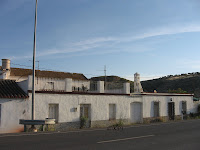Walking around the beach on our usual stroll the other day, I thought I would take a few photos of the local domestic architecture.
There are a few key points to note here:
1) We live in a predominantly agricultural community.
This does not mean that people have huge fincas with acres of olives and all the rest of it - like we all watch on A Place In The Sun.
What it actually means is that most people live in the village and rent ground annually to grow their crops. A few lucky ones, slightly outside the village, have a bit of ground with their houses. These are the houses that most of the pix reflect.
They also invariably happen to be on the main road, not something your average Brit would choose, but it rarely bothers Spaniards.
And of course, in the village, there isn't enough space to have large plots of ground with your house.
2) A lot of the older houses were built out of soft stone from the local quarry. Looks great, incredibly thick walls, and - somewhat porous. Still, it's nice to have a stone house. Dread to think of the cost of that little cute stone cottage in the UK near the coast.
3) Houses when first built tended to have square rooms, maybe - but not always - an entrance hall, and to either side of the front door, a sitting room, and a kitchen, with one or two bedrooms behind. These were the posher houses. Poorer people had two rooms. One to sleep in and one to do everything else in. Cooking happened outside or wherever. Bathrooms didn't happen. Neither did glass windows, or electricity or mains water or.... etc.
There might have been a shady patio outside the bedrooms and/or a corral for the animals. And from this basic houseplan has developed today's village homes.
4) Spanish houses are rarely 'original'.
Spaniards have a positive mania for 'reforming' their houses to the latest ghastly fashion. Reforming basically means, either totally gutting or knocking down and starting again, all with single skin brieze block.
And - as they have to provide for their children - a nice looking single storey cottage will suddenly develop a floor above for their daughter/son plus offspring to live in.
Or the tiny bit of ground they do have, will sprout a single storey two room house, rapidly followed by the upper storey extension a couple of years later.
No mortgages for a lot of families where we live. The families just pitch in to provide a small bit of space for a young couple to start off their life together. But - would you want to live on the back of your parents?
These photos, as far as I know, don't reflect that syndrome - well not over the last ten years, although some do have either a roof terrace, or in one case, a - rare - two storey house that looks older than most of the current reforms. I've tried to show some of the houses that haven't been reformed beyond belief in order to provide homes for little Maria or little José.
So, off on our trip.
I like this house. If only it wasn't on the main road! The guy went to work in Malaga, the place belonged to his parents, and when he had finished his working life in the city, he moved back to the family home. He was lucky and managed to buy a cheap plot of land next to the house so regularly grows potatoes as a cash crop. He also has a similar sized decent plot right behind his house. He has a good sized stable, and a patio and the inevitable few outhouses. Next to the house is the track to the beach. As I say, not a bad house at all.

And from the other angle, the same house.

This guy has a house in the village and this nice place here, surrounded by ground too. Hmm, not without a peseta or so.

A single storey house - where the buildings have surreptitiously crept up the back and the railings signify the roof terrace.

A good example of a classic double-fronted single storey house.

A rare older two storey house - but see the work just above the roof of the house next to it? The two storied house matches in well, but the work on the side gives it away as one that was raised a storey some time ago.

This one has been revamped recently and looks quite striking. The words over the door refer to peones - workers.









1 comment:
Thanks for the interesting tour. Living in Spain vicariously through your wonderful blog.
James
Post a Comment